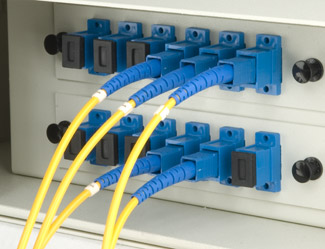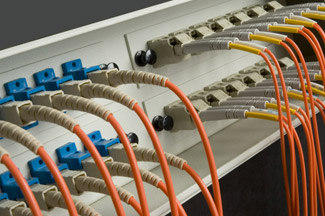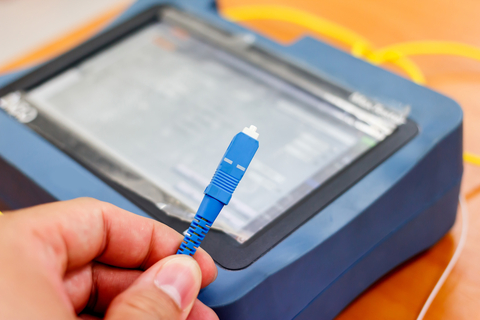With the rapid development of fiber optic communications, fiber optic cables have become an indispensable component for each data center. They’re playing an important part in transmitting data at fast and reliable speed. Yet many router jockeys don’t get enough exposure to fiber cabling, which leads to a wide variety of confusion, misconceptions, and errors when working with fiber optic networks. The purpose of this post is to help you get an in-depth understanding of these topics related to data center fiber cabling.

Fiber cables are internally composed of two layers, the “core” and the “cladding”. They can be classified into two main types: single mode fiber (SMF) and multimode fiber (MMF). When considering the fiber optics for your data center, the most basic thing is to decide between SMF and MMF.
Single mode cable is a single stand of glass fiber with a diameter of 8.3 to 10 microns that has one mode of transmission. Single Mode Fiber with a relatively narrow diameter, through which only one mode will propagate typically 1310 or 1550nm. Carries higher bandwidth than multimode fiber, but requires a light source with a narrow spectral width. Synonyms are mono-mode optical fiber, single mode fiber, single mode optical waveguide, uni-mode fiber. Single mode fiber gives you a higher transmission rate and up to 50 times more distance than multimode, but it also costs more.
Multimode cable is made of glass fibers, with common diameters in the 50-to-100 micron range for the light carry component (the most common size is 62.5).POF is a newer plastic-based cable which promises performance similar to glass cable on very short runs, but at a lower cost. Multimode fiber gives you high bandwidth at high speeds over medium distances. Light waves are dispersed into numerous paths, or modes, as they travel through the cable's core typically 850 or 1300nm. Typical multimode fiber core diameters are 50, 62.5, and 100 micrometers. However, in long cable runs, multiple paths of light can cause signal distortion at the receiving end, resulting in an unclear and incomplete data transmission.
Though fiber cabling has distinct benefits compared with copper in regard to transmission, attenuation and electromagnetic interference (EMI), improper practices of fiber cabling may lead bad effect to data transmission. Therefore, we must maintain the best practices when we doing fiber cabling.
- Inspection & Cleaning: Usually, we do the inspection with fiber microscope (optical microscope or video microscope). It is easy to use but be sure to follow the instruction. In addition, you must beware of bad habits when you doing cleaning. Because cleaning has been part of fiber maintenance for years, most people have their own approaches for cleaning end-faces. However, beware of bad habits as many have developed in the industry over time. In a word, whatever approach is selected, certain truisms apply to fiber optic end-face inspection and cleaning. Strictly follow the defined working process and principles and consistent inspection and cleaning up front will avoid unexpected and costly downtime in the future.
- Fiber Bend Radius: There is a reduction in the strength of that signal when a cable is bent. Similarly, fiber optic cables is also as. The bend radius, or measurement of a curve, can determine how strong the data signal will flow. With fiber cabling, there are different specifications for bend radius varying by cable manufacturer and fiber type. There have been many improvements made in this area, including the development of "bend insensitive fiber". A good rule of thumb for determining bend radius during installation is that bend radius equals 10-15 times the outer diameter of the cable jacket.
- Pulling Fiber: In many cases, fiber cabling must run over long distances. Although fiber optic cabling assemblies are robust and sturdy, it needs to be cautiously used when pulling. It is important to remember that never pull from the connectors because this position is typically the weakest link in pulling strength. In addition, we suggest you to use a pulling sock to reduce strain on critical areas. It is readily available from the related suppliers.
- Tie-down Points: Tie-down point, here we mentioned, is the area where cable is affixed to patch panels or racks and cabinets to ensure they do not move around. To tie-down the fiber cable properly, you may never use zip ties on fiber optic cable unless there are specific designated areas on the cable to do so. The common and proper way is to use Velcro and never over tighten, as this can crack the fiber and cause failure. The following picture shows us the improper and proper ways to tie-down fiber.

As data rates keep increasing, fiber optic cable will become more necessary in many data center applications. A thorough understanding of the basics will help you work better and more higher efficiency. I hope you will enjoy this article and gain some helps or working inspiration from it. In addition, if you have any requirement about the related products, such the fiber cables, fiber patch cord, fiber patch panel or other fiber optic products, you can contact us directly via sales@fs.com.
Reference: http://www.fs.com/blog/basic-knowledge-tips-of-data-center-fiber-cabling.html














